

Damion Smy
Toyota exporting US-built cars to Japan after Trump criticism
3 Days Ago
It may look similar, but the Porsche Taycan has been treated to big upgrades underneath to stay one of the best EVs money can buy.
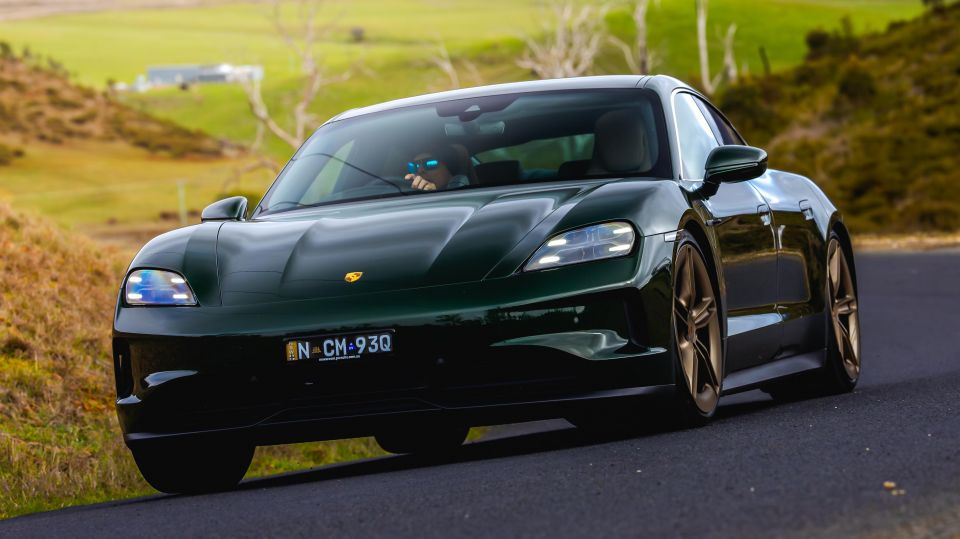
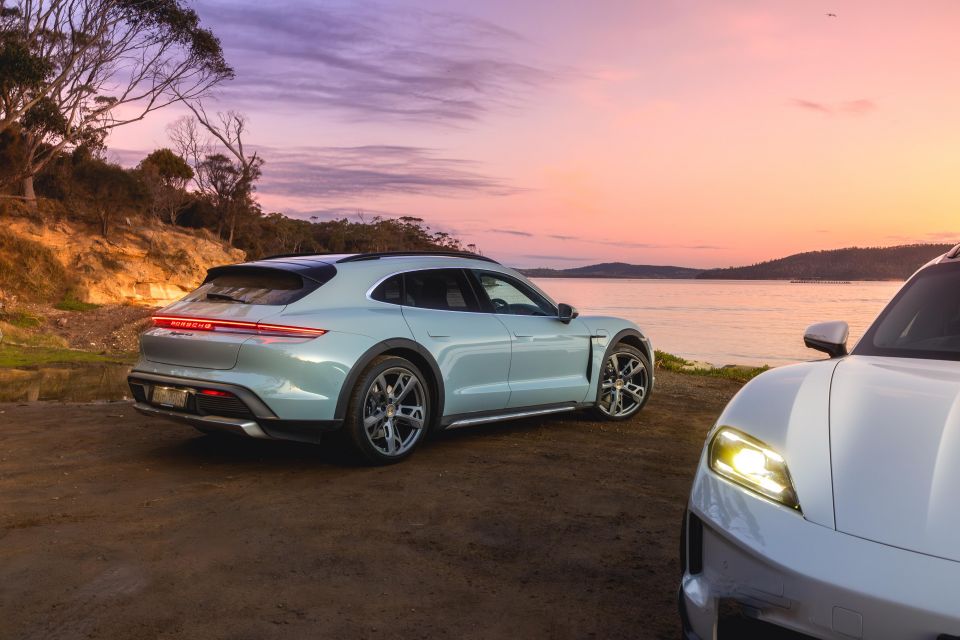

Quickly see how this car stacks up against its competition. Select any benchmark to see more details.
Where expert car reviews meet expert car buying – CarExpert gives you trusted advice, personalised service and real savings on your next new car.
The mid-life refresh of the first all-electric Porsche is being described as “the most comprehensive update in the mid-cycle we have ever done”.

Enter the 2025 Porsche Taycan, codenamed ‘J1 II’ as opposed to the original’s ‘J1 I’ naming. It offers more performance, more range, faster charging, and some smart tech additions.
Porsche AG Panamera and Taycan spokesperson Mayk Wienkötter spoke to some of the extensive investment that went into improving various aspects of the already impressive original EV, which has seen over 150,000 sales since 2019.
Mr Wienkötter said a substantial 25 per cent of the development budget was invested in drivetrain performance, and 29 per cent went into improving efficiency. As such, the company is claiming a more than 30 per cent improvement to WLTP-certified driving range in the new Taycan.
Much of that investment and development was on the back of customer feedback, with range a key theme. Beyond the official figures, Mr Wienkötter says the new Taycan should offer “100 kilometres more range” in any given daily driving scenario compared to the old car.
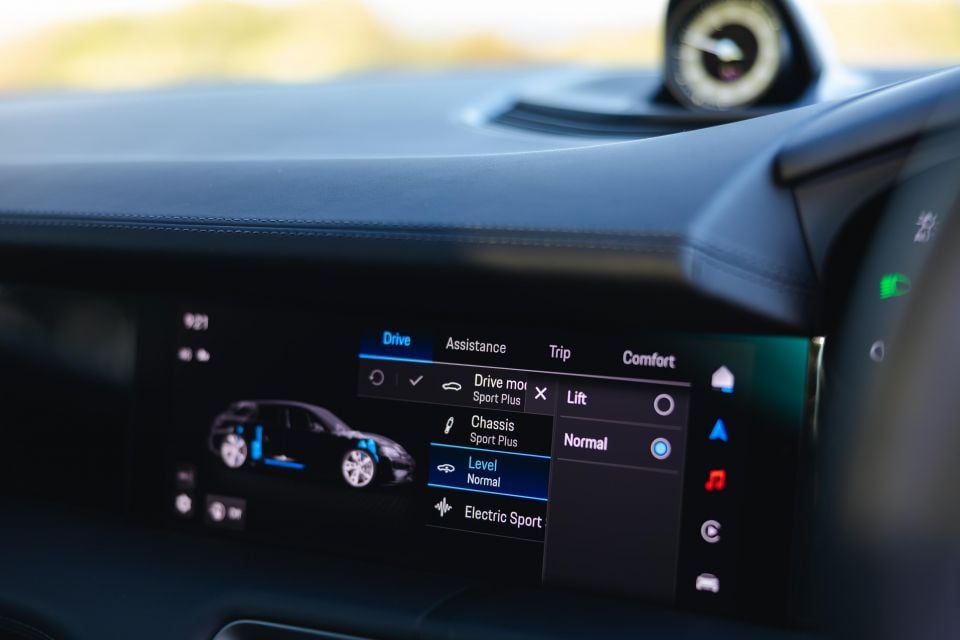
Beyond improvements to the motor and battery efficiency, the new Taycan is quicker thanks to more powerful electric motors across the range.
All models now offer up to 320kW DC fast charging, which when using a 350kW ultra-fast charger can see up to 315km of range replenished in just 10 minutes at the max rate. It’ll charge quicker for longer too, with the minimum start temperature reduced by 20 degrees Celsius compared to the old model.
Porsche has upped energy density and reduced weight of the battery unit despite retaining a similar footprint, too. The new 105kWh Performance Battery Plus offers 12 per cent more overall energy density while weighing 9kg less than the old 93.4kWh unit. Impressive.
More subtle changes include revisions to the exterior design which also improve aerodynamics, echoed in the availability of more aerodynamically efficient wheel designs to maximise range – sense a theme here?
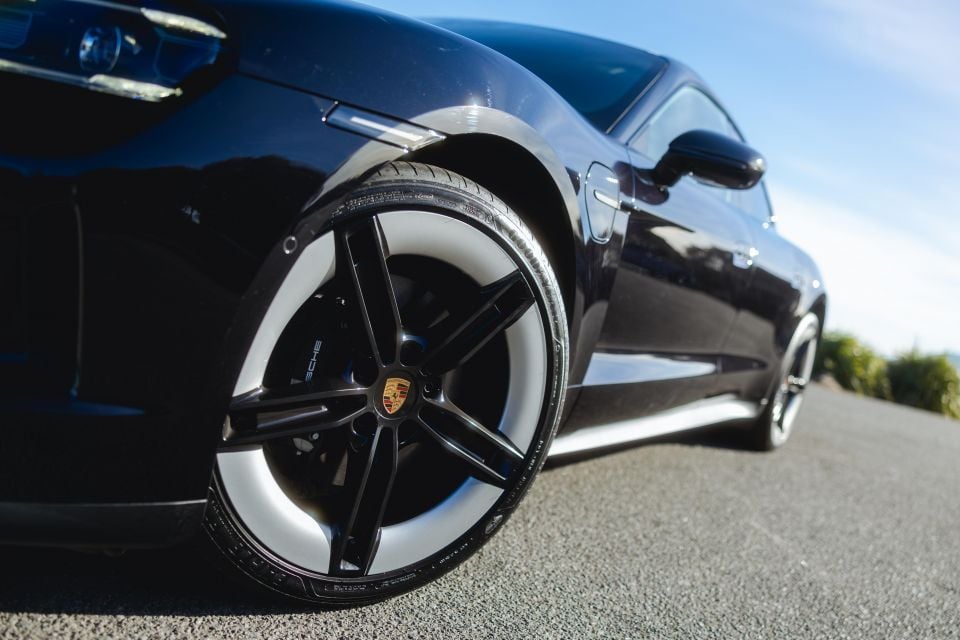
There’s clearly a lot of work that has gone into making Porsche’s all-electric executive performance saloon models (and related Cross Turismo wagon derivatives) even better than their acclaimed predecessors.
Has Porsche delivered another winner? We joined the national media launch on the winding roads of Tasmania to find out.
Pricing for the updated Taycan range has risen by between $10,000 and $15,000 depending on variant.
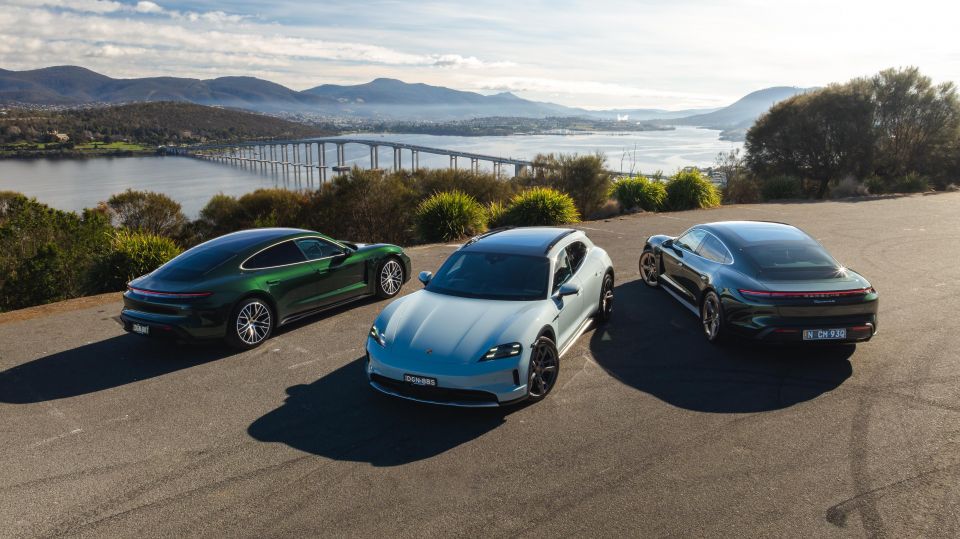
| Model | Price before on-road costs |
|---|---|
| 2025 Porsche Taycan | $175,100 |
| 2025 Porsche Taycan 4 Cross Turismo | $198,000 |
| 2025 Porsche Taycan 4S | $216,300 |
| 2025 Porsche Taycan 4S Cross Turismo | $224,000 |
| 2025 Porsche Taycan Turbo | $307,500 |
| 2025 Porsche Taycan Turbo Cross Turismo | $310,400 |
| 2025 Porsche Taycan Turbo S | $374,200 |
| 2025 Porsche Taycan Turbo GT | $416,600 |
| 2025 Porsche Taycan Turbo GT with Weissach Package | $416,600 |
To see how the Porsche Taycan lines up against the competition, check out our comparison tool.
Buy your new car without the stress. It's fast, simple and completely free.

Great service from Travis and team, second time I have used this business would not hesitate to recommend them to anyone
Craig C.
Purchased a Ford Ranger in Sunshine Coast, QLD
CarExpert helped Craig save thousands on his Ford Ranger, now let us save you on your next new car.
Find a dealLike the exterior, the interior of this ‘facelift’ has been treated to very subtle changes.
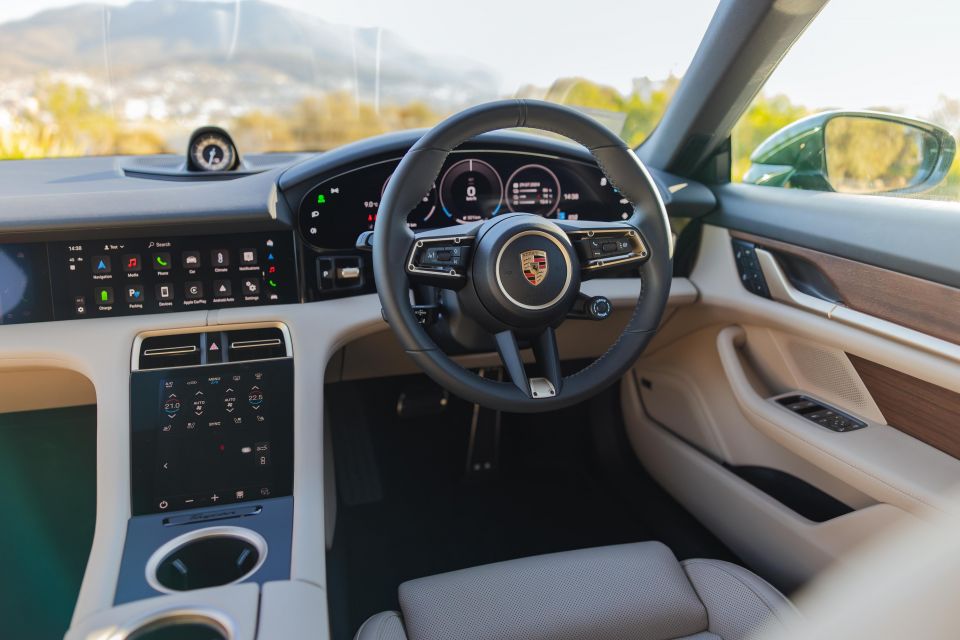
On the launch there were a number of different specifications handy, showcasing the breadth of customisation and personalisation available – very Porsche, but so is the fact a lot of the cooler trims and packages cost extra.
A favourite of mine was the light interior of the Oak Green Taycan 4S with wood inlays and Neodyne accents. It felt suitably old money, and is pictured above.
Key strengths remain, from the somewhat conventional design and layout to the tactile and classic touch points. I love the Porsche steering wheel, and the clicky buttons used throughout the cabin.
Perhaps less favourable is the dash-mounted drive selector, which I often forgot was there. You do get used to it, though. Same goes for the rotary mode selector on the steering wheel, which now has the Push-to-Pass button embedded on variants specified with the Sport Chrono package – more on that later.

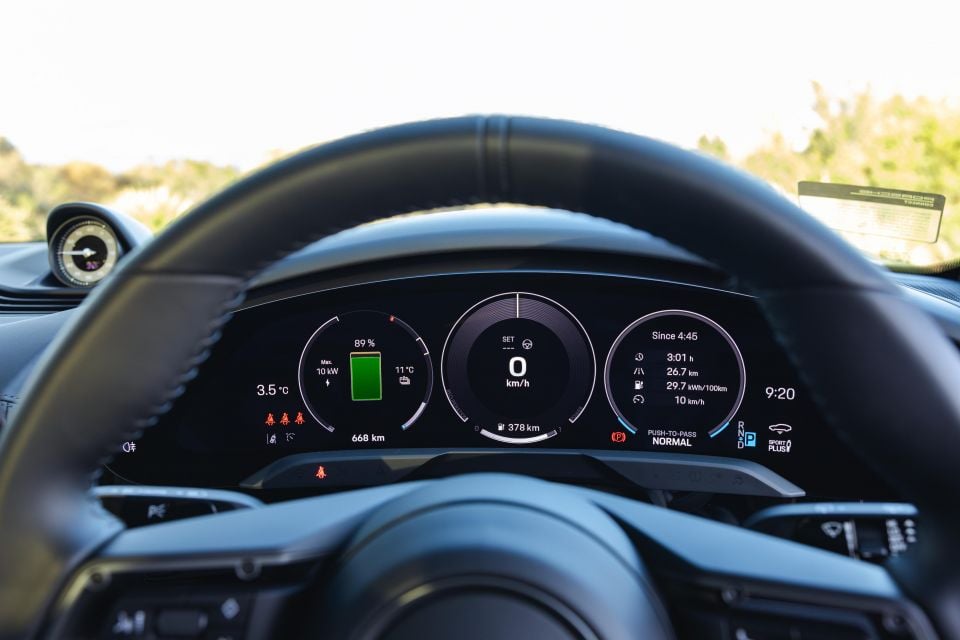
While the overall architecture and design of the interior may appear unchanged at first glance, there have been revisions to the various cabin displays with this mid-life update.
For starters there’s the 16.8-inched Curved Display ahead of the driver, which is already very configurable and now offers a new intelligent battery widget to give you a better idea of charging capability and times right in your field of view.
The widget can show you the target State of Charge (SoC) for the next charging session, as well as the battery temperature and maximum predicted charging rate based on the current conditions. When actually charging, the widget will show the current charging power of the vehicle alongside current battery temperature.
And, should the Taycan not be able to achieve the advertised maximum charge rate, the vehicle will alert you whether the limitation is an issue with the infrastructure or the Taycan. It all makes a lot of sense, but sadly we weren’t able to test it out during the drive program.
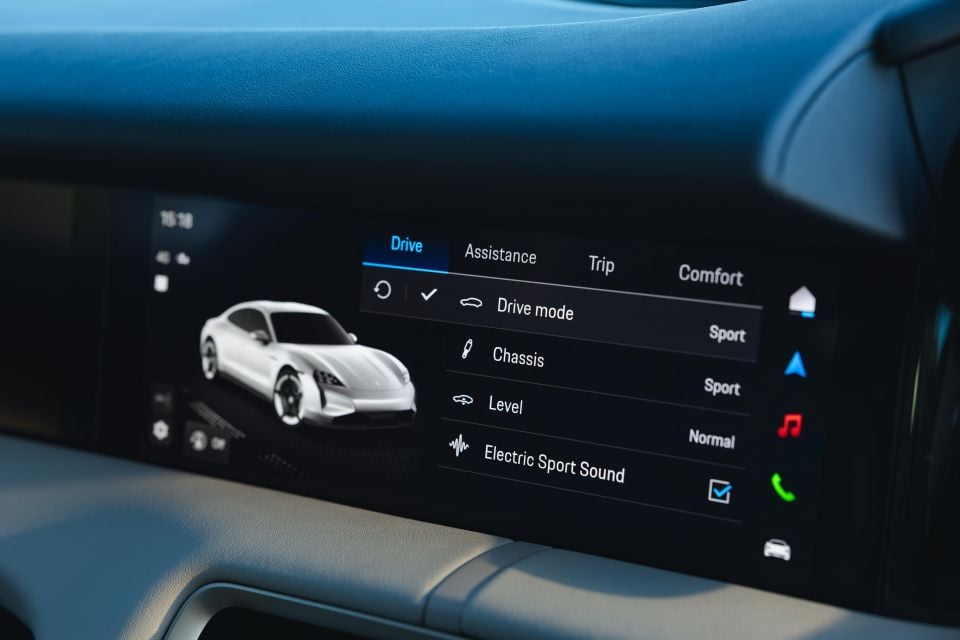
Then there’s the 10.9-inch central touchscreen which can be bolstered by an optional 10.9-inch passenger display, and the supplementary 8.4-inch portrait-oriented touch control display further down.
While Porsche says the interface has been “optimised”, the overall look and feel is pretty much the same as any current Porsche running the latest Porsche Communication Management system. There are some additional functions, though.
The native system does much of the same – vehicle settings, connected navigation, phone and audio – but now there’s deeper Apple CarPlay integration, and there’s a new video streaming function available while the car is stationary on the central display, or always-on for the optional passenger display.
The CarPlay upgrade allows you to control the temperature and the direction of air conditioning system via the smartphone mirroring interface, meaning you don’t have to keep crossing back to the the native Porsche system to change basic car functions.
I can live without the passenger display, which is a $2860 option, and is really just an additional infotainment screen ahead of the front passenger.
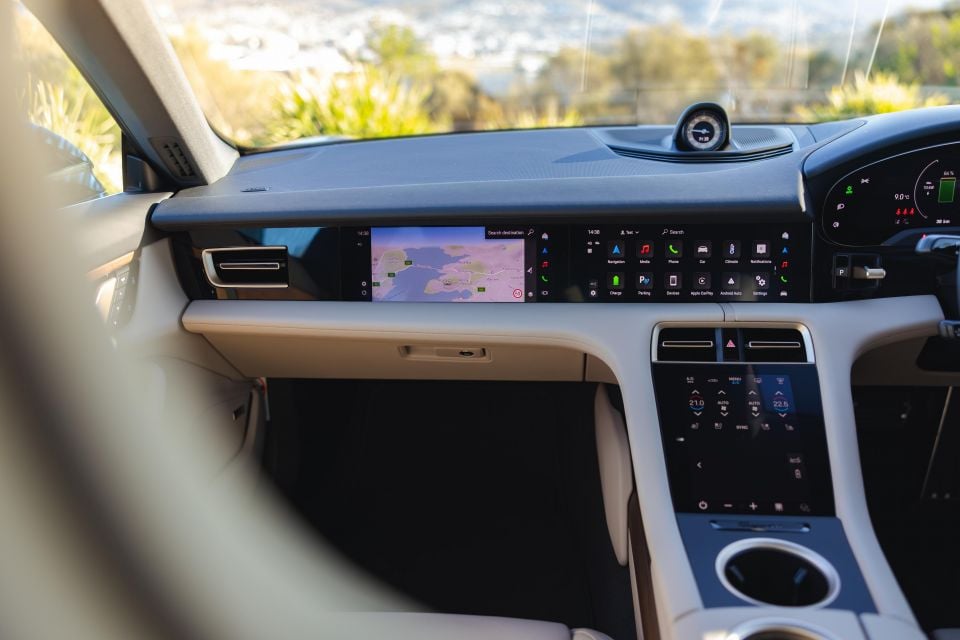
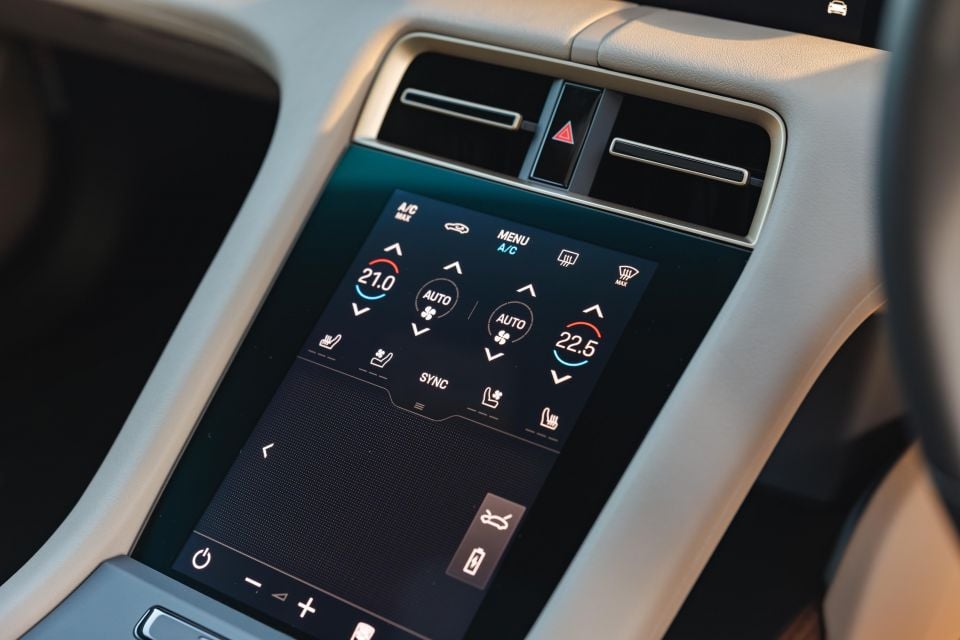
At least it’s nicely integrated and is a neat party trick when you first get the car. It’s otherwise replaced by a piano black panel which is prone to scratches and fingerprints…
Overall the Taycan’s infotainment system remains pretty slick, though it’s a little low-set which requires you to take your eyes off the road if you need to make touchscreen inputs on the move. The clarity and processing power is very good though.
I must lament the touch-based vent direction controls. I don’t understand why a brand that has such history in maintaining tradition felt the need to complicate the process of adjusting air flow. I just want to use my hand to adjust the actual vent, not fiddle with a touchscreen if the air is blowing into my eye or my fingers on the steering wheel…
Also big tick to Porsche Australia for including the 14-speaker Bose surround sound system as standard equipment over the global specification, which offers clear and deep sound quality via its speaker array and 710-watt output.
It also helps to drown out the faint tyre roar on rougher patches of bitumen…

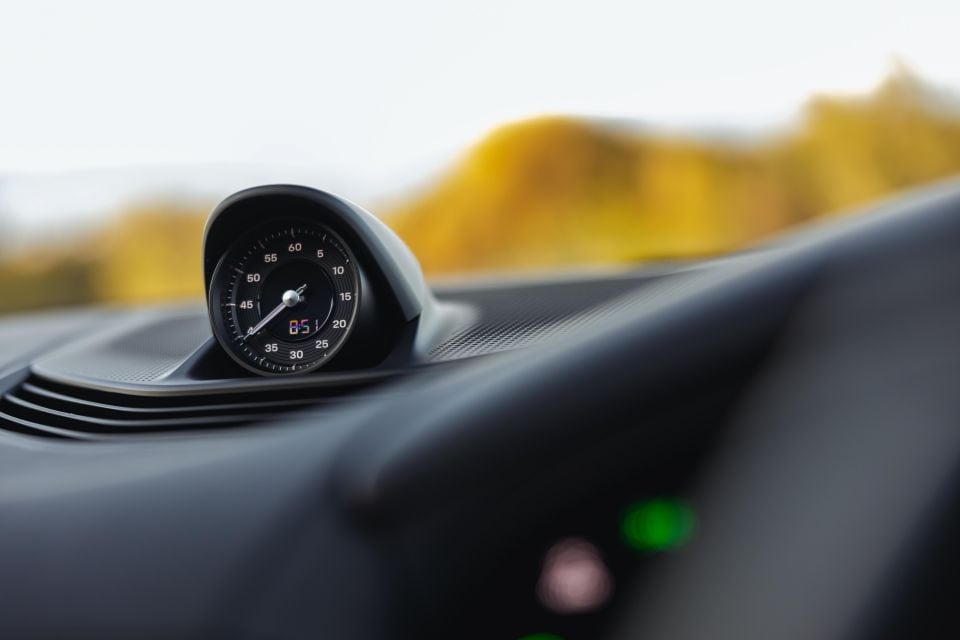
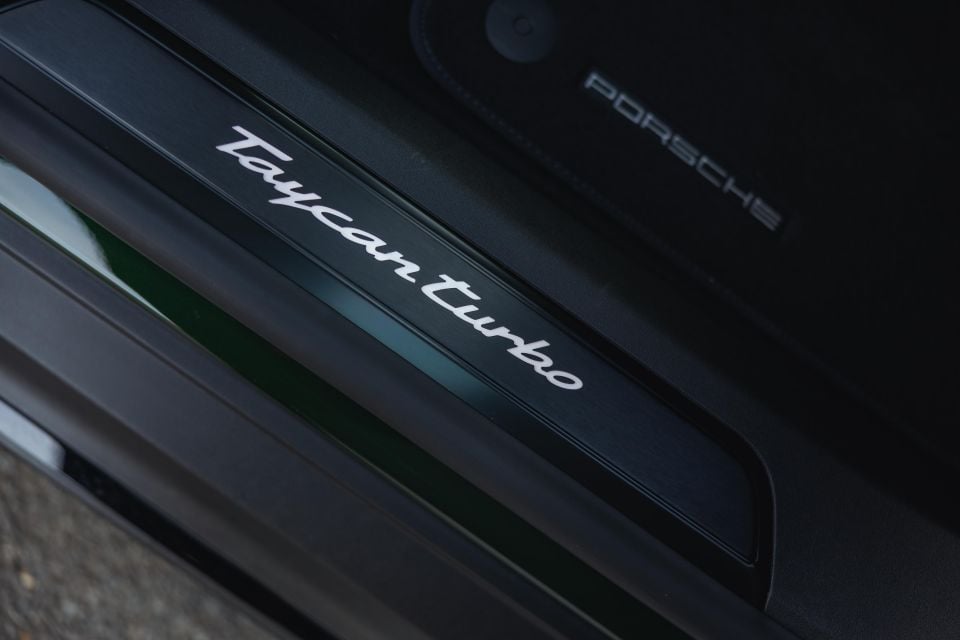
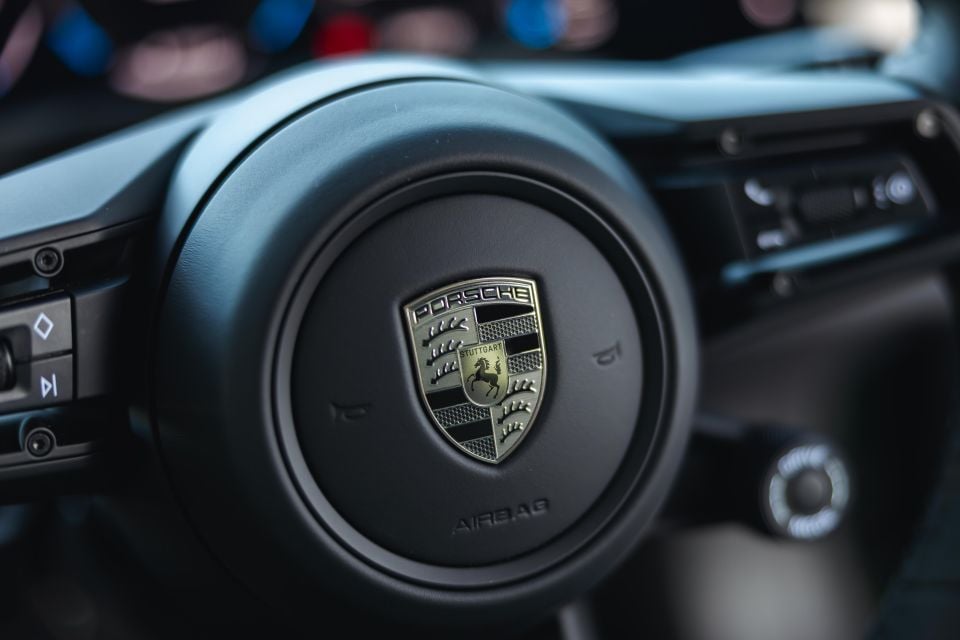
Two seat options are available: standard comfort seats with 14-way electric adjustment and memory, as well as adaptive sports seats with 18 ways of power adjustment. In lower models the latter cost an extra few hundred dollars, but they’re a no-cost option on the Turbo and up.
Both sets of seats proved comfortable and supportive, with the higher-end adaptive sport seats adding extra support and bolstering which was handy for harder driving particularly during our track session at Baskerville Raceway on day two of the event – more on that later.
Another thing you’ll notice if you’re in a Taycan Turbo is the Turbonite badging, which is a new take on the Porsche crest.
Debuted on the latest Panamera, Turbonite is a metallic grey tone with golden undertones and satin highlights. It has been “carefully composed” by Porsche Colour and Trim experts and will replace the golden elements on current Turbo models.
Beyond the badges inside and outside the car, customers can also order a Turbonite finish for the exterior body kit as well as the wheels, if that’s your thing.
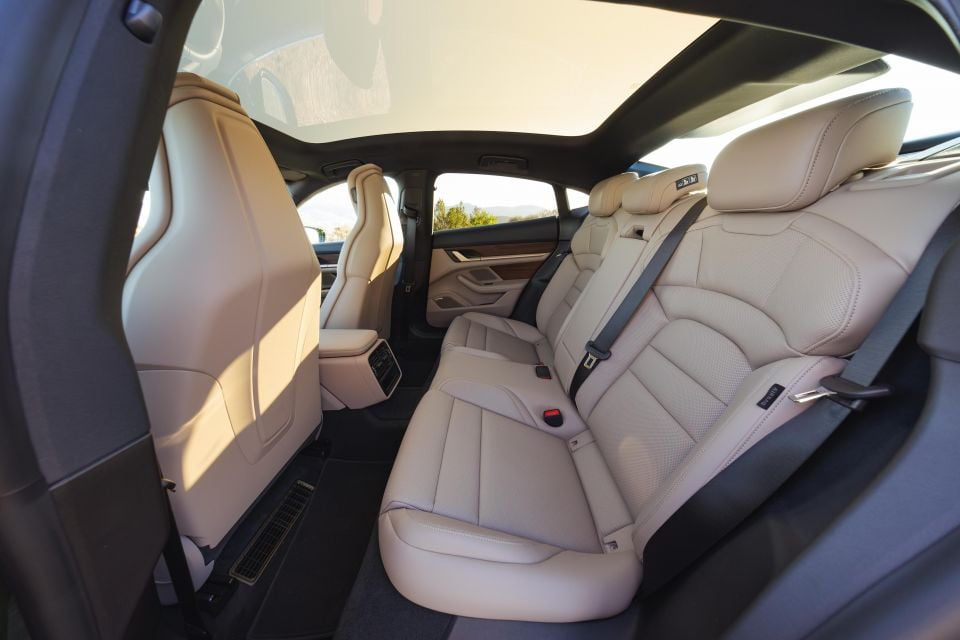
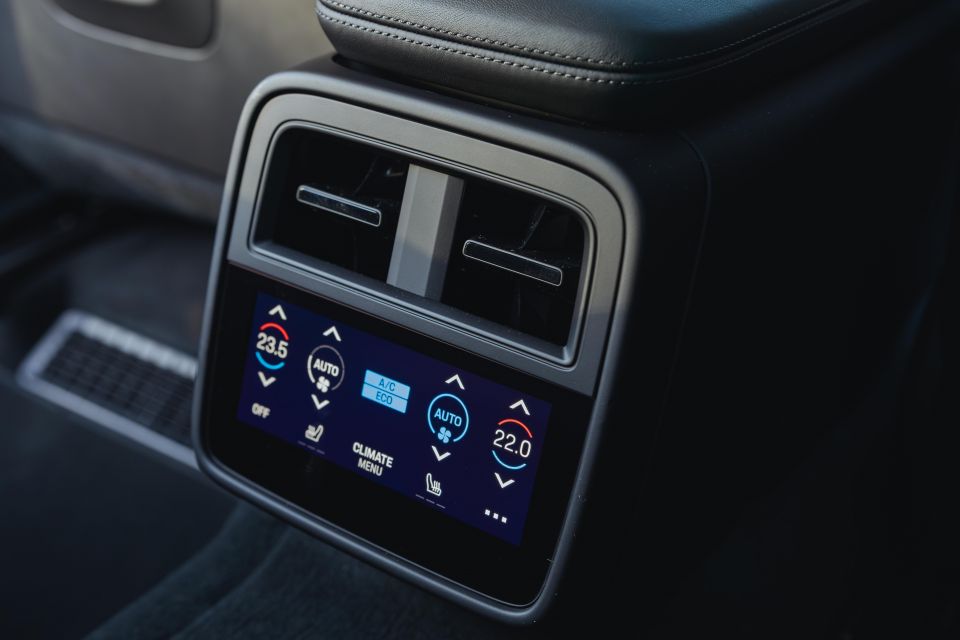
Being an executive sports sedan – or wagon if you get the Cross Turismo – there might be an expectation the Taycan should be able to carry at least two rear passengers in comfort.
If you’re planning on karting larger family members or friends in there often, the higher roofline and slightly longer wheelbase of the Cross Turismo would be preferable. Headroom in the standard Taycan is a little tight for 6’1 me, but it’s bearable. Think of the Taycan as more of a four-door coupe rather than a proper large sedan like the Panamera.
As standard there are only four seats, too. You can option 4+1 seating for a little extra across the range if you want to, but the middle seat would be best left for emergencies.
Knee and toe room is fine provided you don’t have anyone too lanky up front, and there are amenities like rear air vents and a fold-down centre armrest with cupholders. Four-zone climate control with touchscreen controls are standard from the Turbo up, and available as a cost option on lower grades.
As you’d expect, there are the requisite ISOFIX and top-tether anchors across the second row as well.

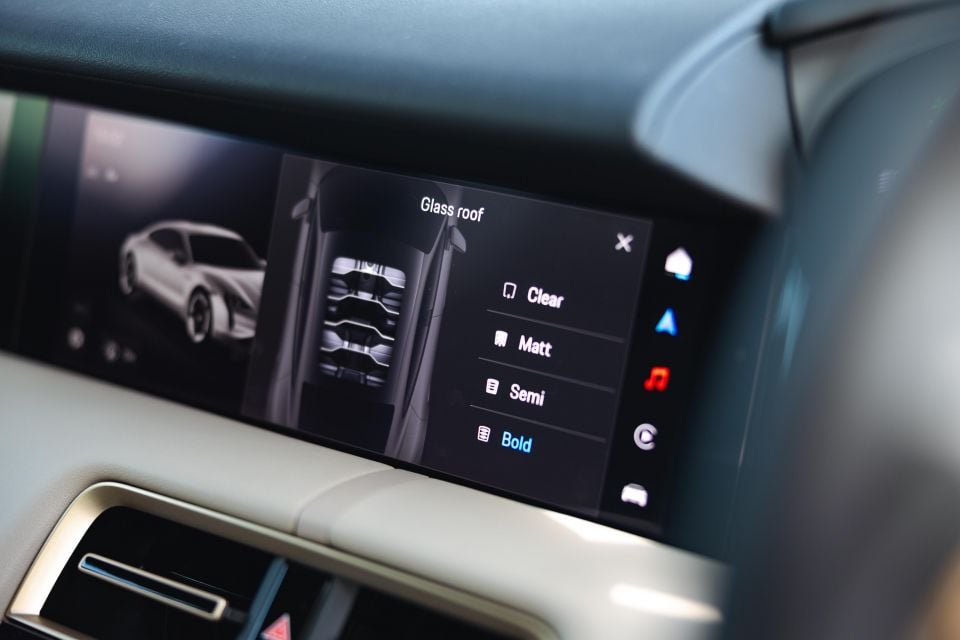
The available panoramic roof system is a no-cost option from the 4S and above, and lets in plenty of light to make the cabin feel a little airier. Additionally, you can option the new-for-Australia Variable Light Control.
How does it work? In place of a conventional sunshade which eats into headroom, Variable Light Control uses liquid crystals in the multilayered roof pane to go opaque or transparent using electric voltage.
Adjustable via the central touchscreen, the optional roof system offers multiple settings by blanking out different segments, of which there are nine.
Not only is this a fun tech piece, Porsche says the roof system lets twice as much light into the cabin while also offering better heat resistance compared to conventional shade systems courtesy of the insulating silver coating.
While the standard fixed glass roof is a no-cost option on most grades, the upgraded roof with Variable Light Control commands a hefty $7100 premium, even on the Turbo. Cool, but ouch…

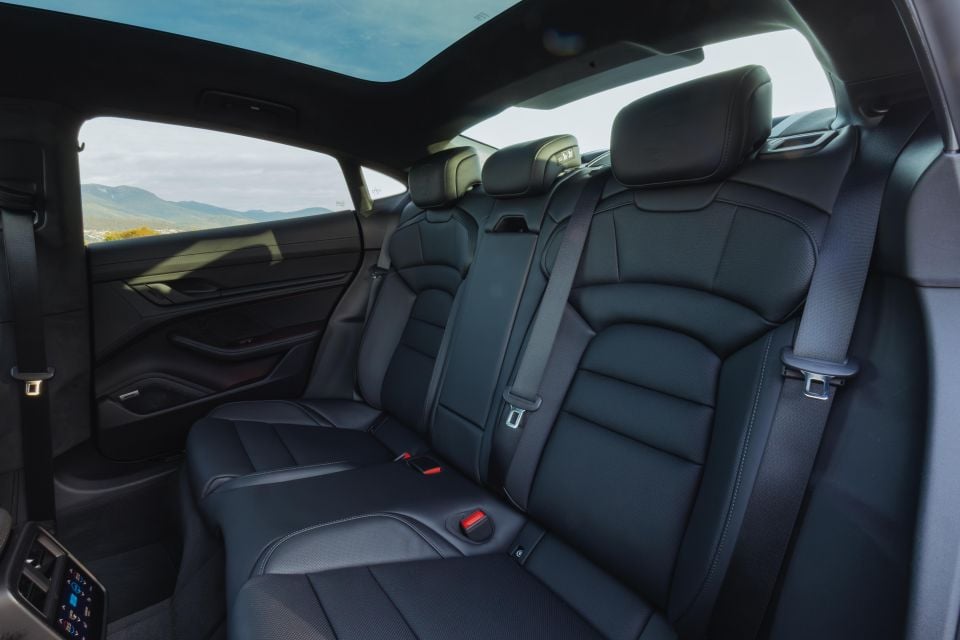
Despite the Taycan’s near 5.0-metre length in both body styles, there’s not a whole lot of boot space behind those rear seats – we unfortunately don’t have any shots of the cargo area to illustrate, but here are the specs.
Both the Taycan and Taycan Cross Turismo quote 366 litres of capacity with the rear seats in place, bolstered by an additional 84 litres in the ‘frunk’. Porsche doesn’t quote a figure with the rear seats folded.
It’s a fairly shallow space by height but appears quite deep, and we managed to fit four people’s worth of carry-on suitcases and bags in the standard Taycan on an airport run.
As is the case with an increasing amount of luxury vehicles and in particular EVs, there’s no spare wheel of any type but rather a tyre repair kit including air compressor.

Where expert car reviews meet expert car buying – CarExpert gives you trusted advice, personalised service and real savings on your next new car.
| Dimensions | Porsche Taycan | Porsche Taycan Cross Turismo |
|---|---|---|
| Length | 4962-4963mm | 4974mm |
| Width | 1966mm | 1967mm |
| Height | 1378-1381mm | 1409-1412mm |
| Wheelbase | 2900mm | 2904mm |
| Cargo capacity | 84 litres (front) 366 litres (rear) | 84 litres (front) 366 litres (rear) |
To see how the Porsche Taycan lines up against the competition, check out our comparison tool.
Prepare for some data tables…

2025 Porsche Taycan J1 II
| Specifications | Taycan | Taycan 4S | Taycan Turbo | Taycan Turbo S |
|---|---|---|---|---|
| Drivetrain | Permanent magnet synchronous motor, rear axle | Dual permanent magnet synchronous motors, front and rear axles | Dual permanent magnet synchronous motors, front and rear axles | Dual permanent magnet synchronous motors, front and rear axles |
| Battery | 83.6kWh (net) 97.0kWh (optional) | 97.0kWh (net) | 97.0kWh (net) | 97.0kWh (net) |
| Power | 300kW 320kW (97kWh) | 380kW | 520kW | 570kW |
| Power (Overboost) | 320kW | 440kW | 650kW | 700kW |
| Torque | 420Nm | 710Nm | 940Nm | 1110Nm |
| Driven wheels | Rear | All-wheel drive | All-wheel drive | All-wheel drive |
| Weight (unladen) | 2090kg (83.6kWh) 2170kg (97.0kWh) | 2250kg | 2290kg | 2295kg |
| 0-100km/h (claimed) | 4.8 seconds | 3.7 seconds | 2.7 seconds | 2.4 seconds |
| 0-200km/h (claimed) | 15.8 seconds | 12.0 seconds | 8.2 seconds | 7.7 seconds |
| Power consumption (claimed) | 17.1kWh/100km | 17.8kWh/100km | 17.8kWh/100km | 17.8kWh/100km |
| Claimed range | 566 kilometres | 635 kilometres | 626 kilometres | 626 kilometres |
| Max DC charge rate | 320kW | 320kW | 320kW | 320kW |

2025 Porsche Taycan Cross Turismo J1 II
| Specifications | Taycan 4 | Taycan 4S | Taycan Turbo |
|---|---|---|---|
| Drivetrain | Permanent magnet synchronous motor, rear axle | Dual permanent magnet synchronous motors, front and rear axles | Dual permanent magnet synchronous motors, front and rear axles |
| Battery | 97.0kWh (net) | 97.0kWh (net) | 97.0kWh (net) |
| Power | 320kW | 380kW | 520kW |
| Power (Overboost) | 320kW | 440kW | 650kW |
| Torque | 420Nm | 710Nm | 940Nm |
| Driven wheels | All-wheel drive | All-wheel drive | All-wheel drive |
| Weight (unladen) | 2280kg | 2280kg | 2320kg |
| 0-100km/h (claimed) | 4.8 seconds | 3.7 seconds | 2.7 seconds |
| 0-200km/h (claimed) | 15.8 seconds | 12.0 seconds | 8.2 seconds |
| Power consumption (claimed) | 18.5kWh/100km | 18.5kWh/100km | 18.6kWh/100km |
| Claimed range | 601 kilometres | 597 kilometres | 597 kilometres |
| Max DC charge rate | 320kW | 320kW | 320kW |
| Charging time 10-80 per cent (Max DC) | 18 minutes | 18 minutes | 18 minutes |
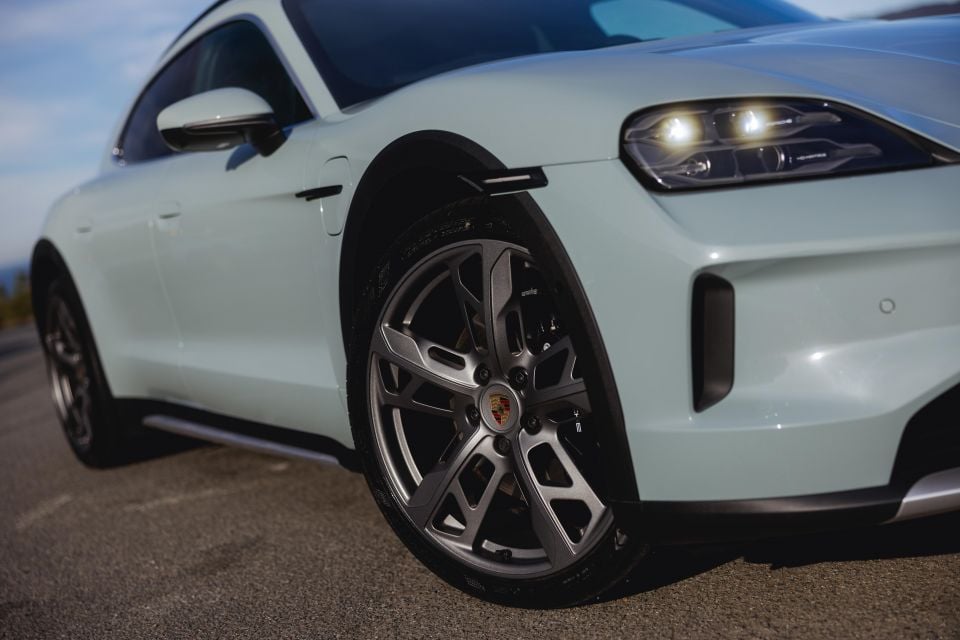
The Taycan retains its two-speed transmission on the new rear-axle motor which adds up to 80kW of power over the old one, while the front motor in AWD models has a single-speed unit.
Higher energy density (via new cell chemistry) in the battery increases range by 14 per cent, while drivetrain efficiency improvements up it by another 5.0 per cent, and there’s a further 11 per cent improvement thanks to mass, aero and rolling resistance optimisation.
New Aero Design wheels measuring 21 inches can add up to 40 kilometres of range compared to the eye-catching Mission E design too, the company says. There’s also a new pulse inverter, heat pump and revised thermal management to further enhance performance and efficiency.
Further, the increase in DC charging capacity to 320kW (from 270kW) is coupled with longer maximum charging performance. The Taycan will allow fast charging from a much lower battery temperature too, at 15 degrees Celsius versus the old model’s 35 degrees.
What this all means is the Taycan will replenish more range, quicker. An official Porsche graph comparison using the base Taycan RWD saw the new model replenish 315km of range in 10 minutes at the maximum charge rate, versus 225km in its predecessor.
For the tech heads, the J1 II Taycan quotes a max charging current of 400A (from 336A), a max launch control current of 1100A (from 860A) and energy density gross figure of 168.3Wh/kg (from 148.7Wh/kg).
The Taycan’s regenerative braking has also been improved, now able to capture up to 400kW of energy under brakes at higher speed. It’s so good that there’s now a service item in the schedule where the brake pads need to be changed every six years because they harden over time from not being used. Fancy that.
To see how the Porsche Taycan lines up against the competition, check out our comparison tool.
The Australian launch drive of the new Taycan took place on the winding roads of south eastern Tasmania.
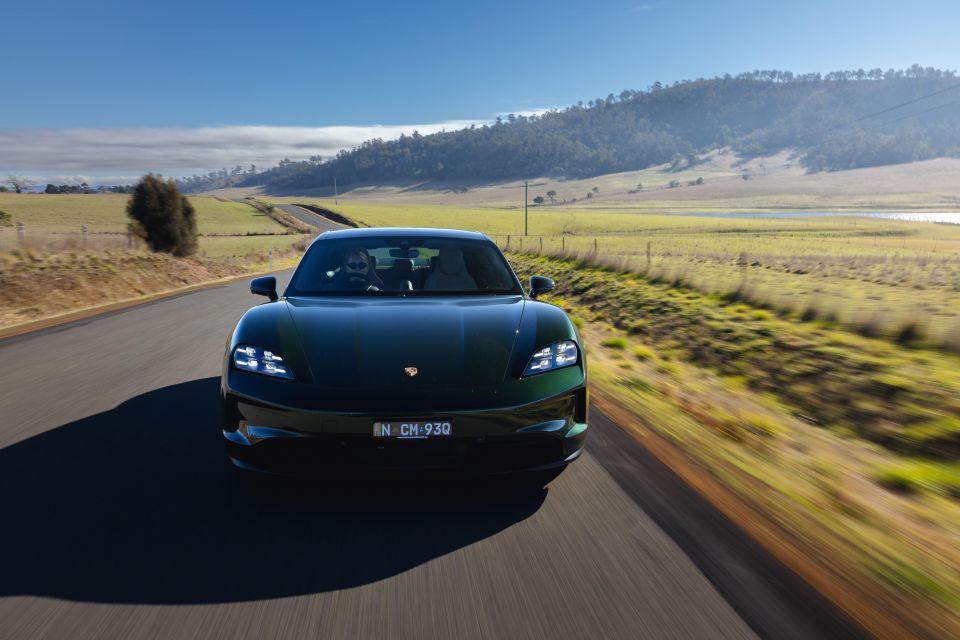
We drove hundreds of kilometres in total through Australia’s southernmost state, cycling through the base rear-drive Taycan, the Taycan 4 Cross Turismo, Taycan 4S and 4S Cross Turismo, as well as the 700kW Taycan Turbo.
I decided to start from the bottom of the range and work my way up. Save the ‘best’ until last, right?
My time in the base Taycan started from the Hobart Airport carpark and for about an hour out of town. Our test car didn’t have the Performance Battery Plus ($12,020) option which also bumps max power from 300kW to 320kW.
Even in its base form, the entry-level Taycan is still plenty quick, quoting a 0-100km/h time of 4.8 seconds which not long ago was the standard pace of V8-engined Mercedes-AMG products and various sports cars.
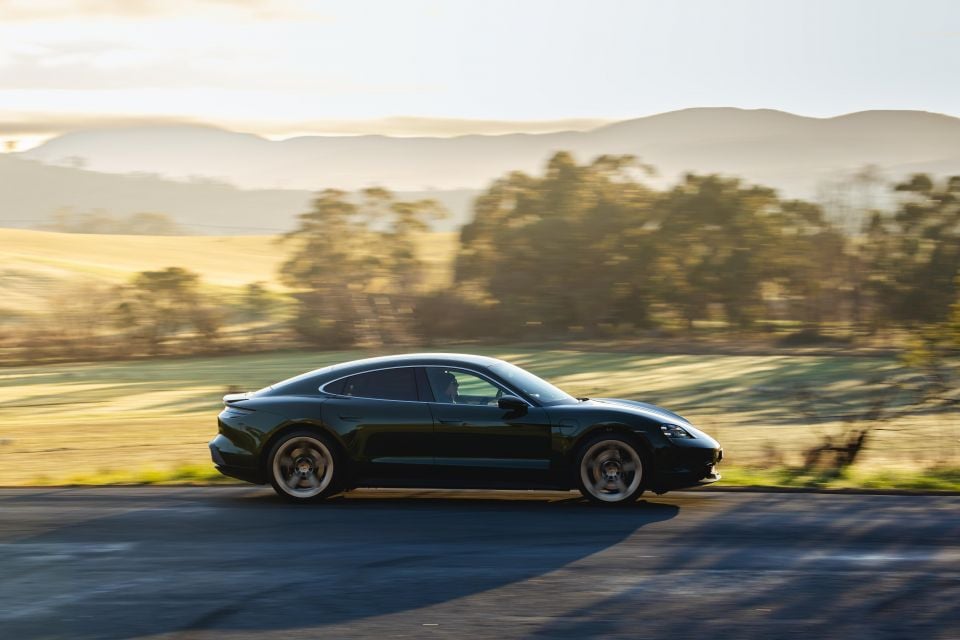
Power delivery is smooth and responsive even in its Comfort mode, only heightened by flicking the rotary mode selector dial into Sport.
Having not spent a huge amount of time in the Taycan in the past, it was really enriching to get some extended wheel time in the most affordable version (and subsequently, the rest of the range). Even in its base form, the Taycan is a brilliant thing to drive and definitely injects old-school feel and engagement into the EV driving experience.
The rear-drive balance gives it the feel of a classic high-end luxury sedan, and the immediacy of its acceleration response is quite addictive. It also has the quiet refinement typical of zero-emissions vehicles.
It’s 200kg lighter than the dual-motor models too, which endows it with lovely handling, aided further by the wonderfully direct and quick steering feel.
I can see why you might be perfectly happy with getting the base model with some choice options, especially in Australia. You’d almost feel like the insane power and track-capable talents of the Turbo models is a waste on Australia’s strictly governed roads.
While the Taycan 4 Cross Turismo gets dual-motor all-wheel drive it offers the same outputs as the base car. To get a proper bump in performance you need to step up to the Taycan 4S.
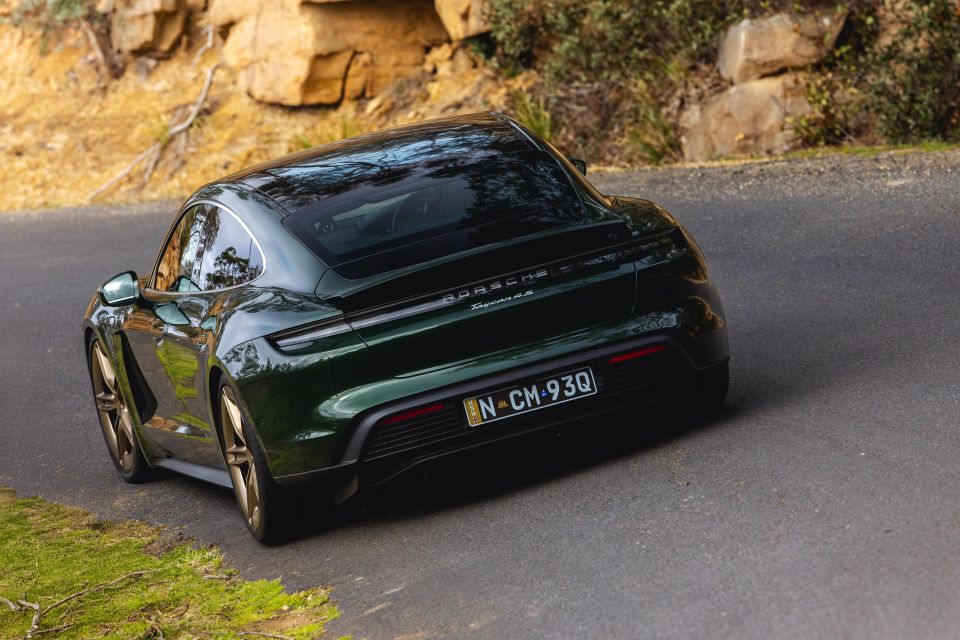
The beautifully optioned Oak Green example pictured rolling on Neodyne wheels is my sweet spot in the local Taycan range. With up to 440kW on tap and a 0-100km/h claim of well under 4.0 seconds, it’s already a brute of a thing before you start chasing more performance further up in the range.
Pop it into Sport or Sport Plus and the sheer thrust available under foot at any given time is very impressive. Time and time again you can shoot yourself towards the horizon accompanied by Porsche’s Electric Sport Sound ($1050), giving it this futuristic spaceship vibe that’s addictively fun to sink your boot into.
It’s again the Porsche’s excellent steering feel that really differentiates it from the related Audi e-tron GT. Through high-speed country roads and winding passes, the Taycan 4S really shrinks around you in a way a 4.9m-long, 2.2-tonne electric luxury car really deserves to.
The Taycan is even more impressive when you factor in its excellent ride quality. The standard adaptive air suspension is very well tuned so that you can actually drive this in Sport on the daily and not tire of an overly firm feel.
There’s also a new push-to-pass function for models equipped with the Performance Battery Plus and Sport Chrono package, providing up to 70kW of boost for 10 seconds by pressing the button in the centre of the rotary mode selector. Like Porsche’s overboost function in its combustion cars, it’s great for quick overtakes or bursts of thrust.
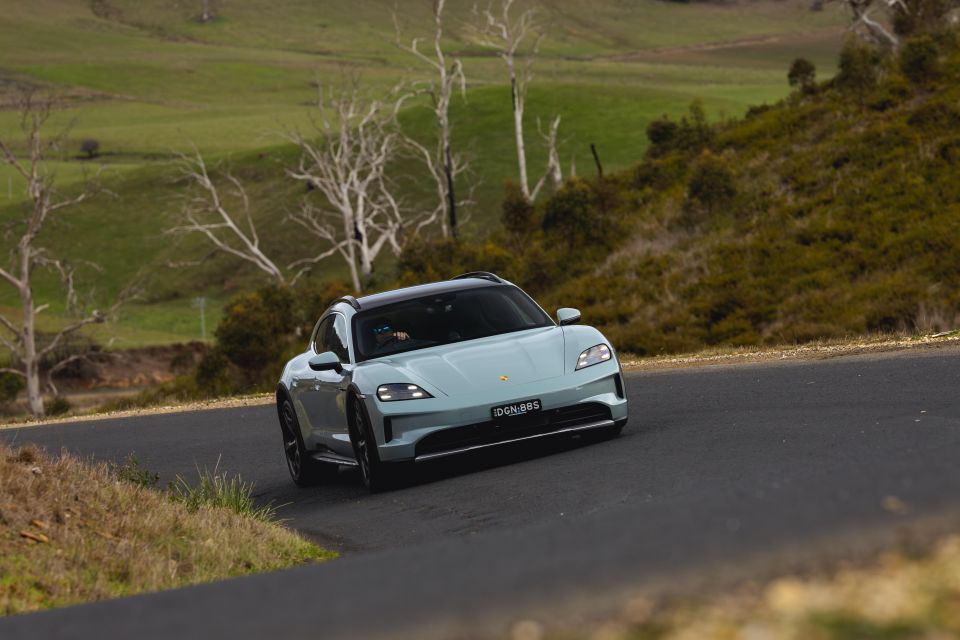
By comparison, the Cross Turismo versions felt a touch softer but just about as capable at handling a series of twisties. Until you hit the race track (which we did, but assume most owners won’t), the differences are pretty minimal.
The Cross Turismo rides about 20mm higher than the standard Taycan, but at 146-148mm it’s still lower to the ground than most passenger cars and barely any heavier than the sedan. It’s still a focused and dynamic machine worthy of the Porsche crest on the nose.
If the standard Taycan on air suspension is comfortable if taut, the Cross Turismo adds a touch of extra compliance that give it a more wafty feel. For daily tasks and highway touring, the crossover wagon wins out.
Otherwise, it’s a very similar experience with the same battery, motors and optional powertrain sounds. That lovely steering gives you confidence to corner hard in this thing, as does the hunkered-down feel and huge levels of grip.
We’ll get to the Turbo on track in a sec, but a highlight of the Taycan for me is the wonderful consistency to the range in the overall feel, which means you’re getting a wonderful driving experience regardless of whether you go for the $170,500 Taycan or the $310,400 Taycan Turbo Cross Turismo.
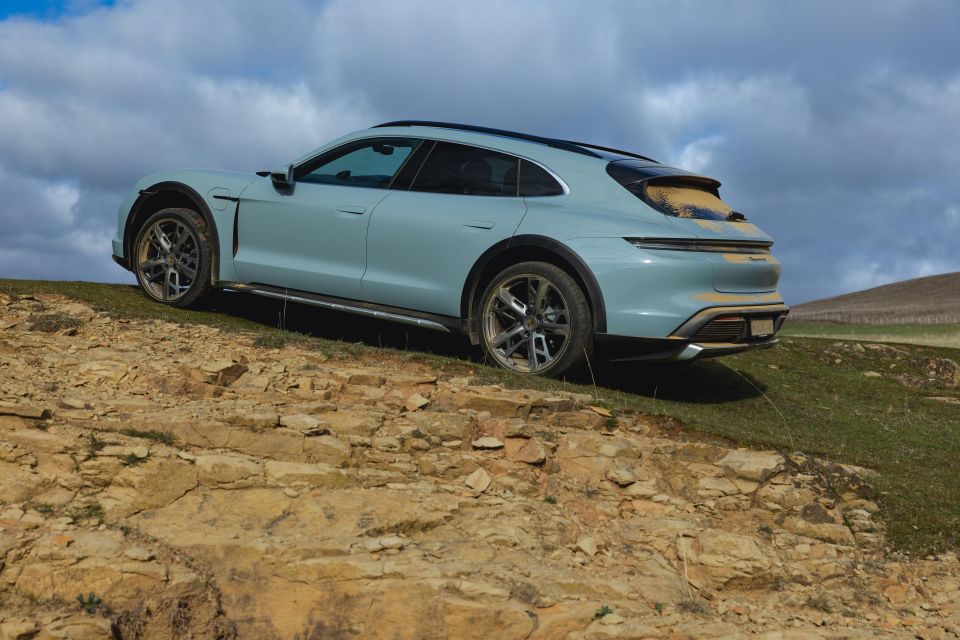
I remember a time where journalists would urge you to avoid any Porsche that didn’t have the ‘S’ moniker, and quite frankly that isn’t the case with the Taycan. All of them are bloody brilliant to drive.
Compared to the Audi e-tron GT I reviewed not too long ago, the Porsche feels that bit more dialled in and direct in the ride and handling. The steering of the Taycan is tighter and less assisted in feel, while the ride is perhaps less cosseting but does a wonderful job at communicating the road surface without being unrefined.
The only other thing I can knock the Taycan for is road noise. While far from loud or refined, there was consistent tyre roar particularly over rougher patches of Tasmania’s regional roads that created a bit of droning at higher speeds. It’s not bad, but could definitely be better, given the car’s luxury-leaning status.
It’s worth noting we didn’t get to trial Porsche’s new Active Ride system. This is an active anti-roll system hooked up to the 800V electrical architecture which basically keeps the car completely flat though lateral and pitching movements when accelerating or braking.
The system is meant to be quite trick, but it’s a whopping $16,980 on the 4S!
Other highlights of the system include Comfort Entry, which jacks the Taycan up 5.5cm for easier ingress and egress; and the Dynamic Ground Clearance function can drop the ride height by up to 3.3cm for better handling.
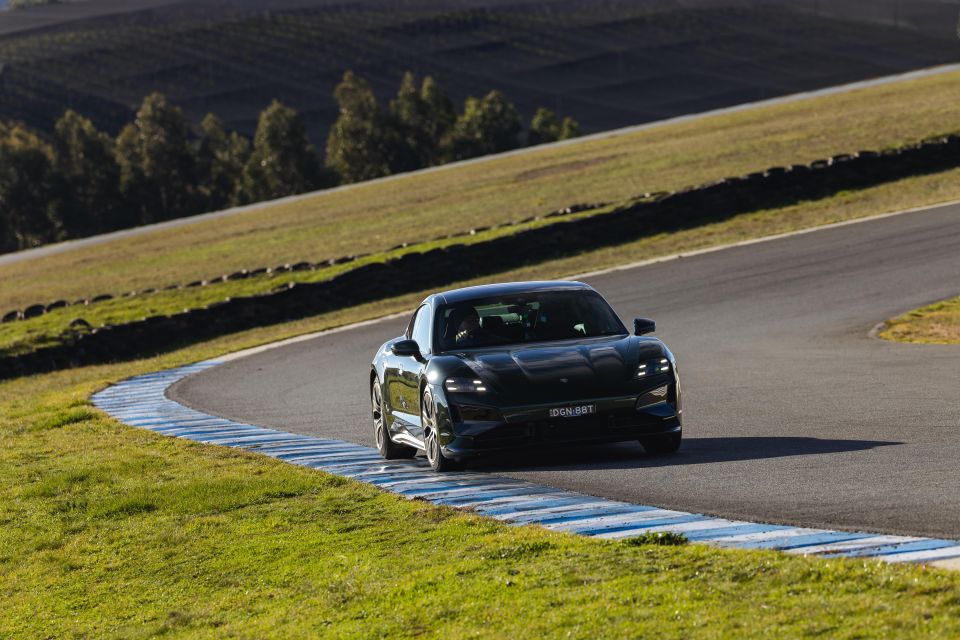
Now, the track…
It was my first visit to Tassie’s Baskerville Raceway, a quiet little technical track at the foot of the hills north of Hobart. If the track day wasn’t going to be great fun, the scenery had already set a wonderful tone.
We again cycled through all the variants for 0-100km/h testing and then guided laps following instructors in Cayenne E-Hybrids, and this was my first stint behind the wheel of the Taycan Turbo.
An acceleration test revealed the brand’s 2.7-second 0-100km/h claim is entirely achievable. I managed around 2.8 seconds after multiple journalists had done their runs, and the simple activation of Launch Control (Sport Plus, hard brake, hard throttle) means it’s a very easy process to complete and replicate.
To experience this level of acceleration in a big sedan, that was in an admittedly understated spec as tested, was insane. It genuinely felt like my stomach shot into my throat and then back down out my bottom.
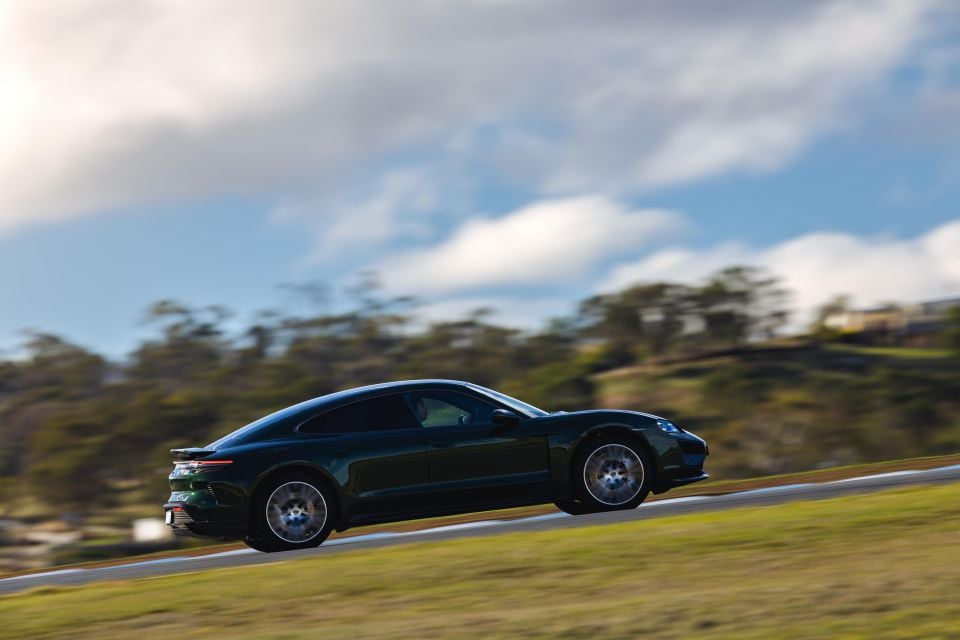
On the guided laps, the Turbo was almost too easy, as you could make up for a sloppy corner by throttling hard to make up any gaps with the lead car.
Again its insane performance (mind you, there are faster Turbo S and Turbo GT versions coming) was on full display. I reached 170km/h on the back straight in what seemed like an instant, and it felt like it had more to give. Porsche claims the Turbo can accelerate from rest to 200km/h in just 7.7 seconds, which is quicker than a lot of cars get to 100km/h!
Just as impressive is the Taycan’s ability, in all its variations on test, to handle on a circuit. Again, this is a 5.0m-long, 2.2-tonne car that you can confidently punt around a technical track like Baskerville, and even then I didn’t think I pushed any of them to their absolute limit like a professional driver could.
Even after several track sessions including three- to four-lap rounds by multiple drivers, it didn’t feel as if the Taycans were starting to fade in brake feel or lose their iron-clad grip on the track surface.
That in itself is cause for praise, as few EVs can feel like a properly capable performance car in these kinds of driving conditions. The Taycan isn’t merely an electric performance car, it’s a performance car that happens to be electric.
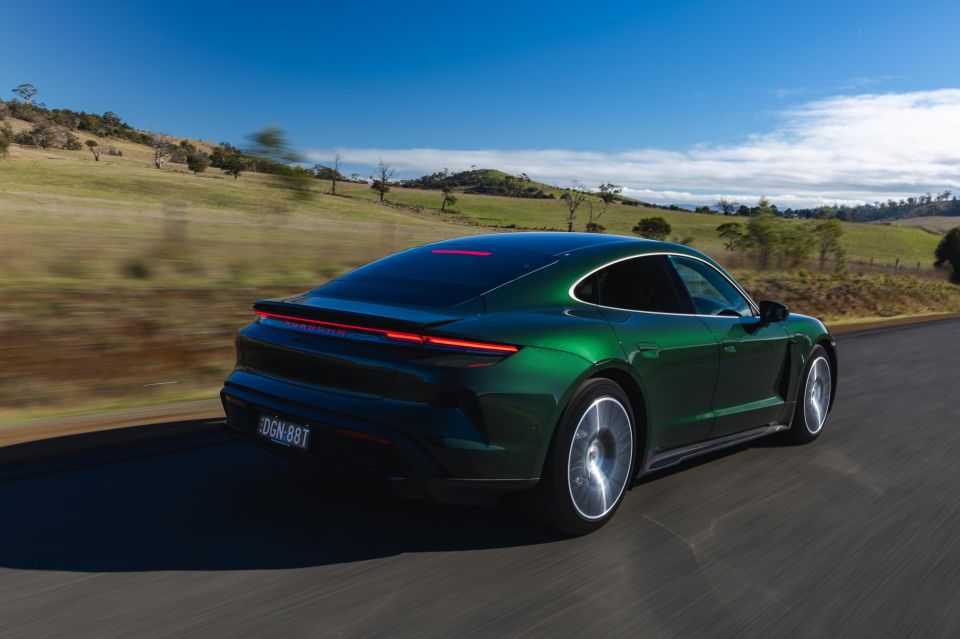
Dialling it back a bit again, Porsche’s driver assistance systems tend to be among the best in terms of accuracy and ease of use.
Australia gets an enhanced suite of assists as standard over the global specification, meaning adaptive cruise control, blind-spot monitoring and a surround-view camera with 3D view are included from the base level.
You can toggle most systems so you can either give the Taycan licence to drive semi-autonomously on the highway or you take full control.
While some owners will no doubt prefer to go sans electronic nannies and aids, the Taycan’s tech hero positioning and luxury saloon segmentation means these inclusions are worthwhile and necessary.
Just in case you couldn’t already tell… I really liked this thing.
Porsche Australia adds a number of equipment items over the standard global specification.

Taycan standard features:
New standard equipment for MY25:
Taycan 4S adds:
Taycan Turbo adds:
New standard equipment for MY25:
The Porsche Taycan doesn’t wear an ANCAP safety rating, though the original achieved five stars in Euro NCAP tests back in 2019.
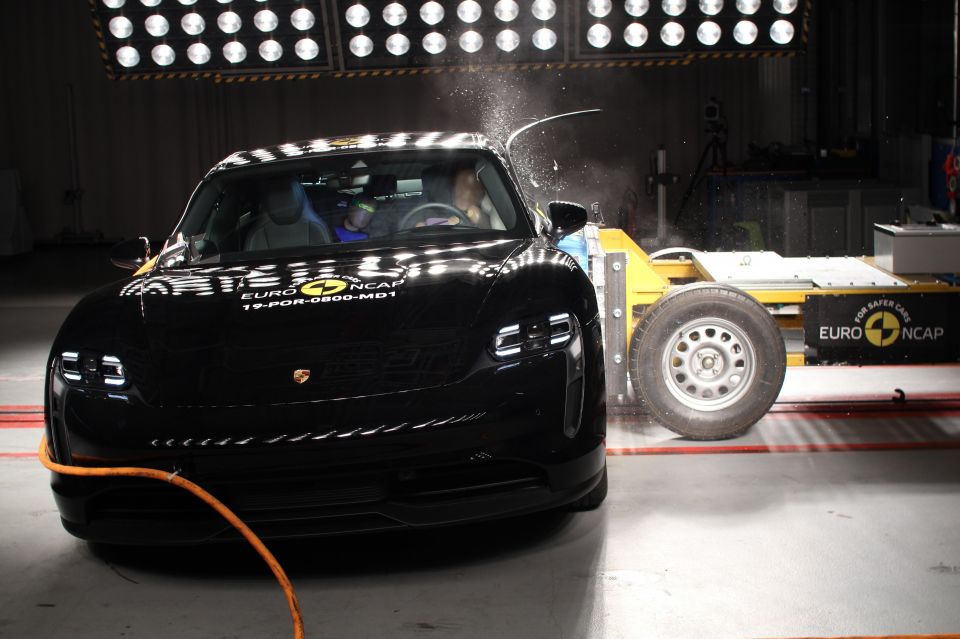
| Category | Porsche Taycan |
|---|---|
| Adult occupant protection | 85 per cent |
| Child occupant protection | 83 per cent |
| Vulnerable road user protection | 70 per cent |
| Safety assist | 73 per cent |
Standard safety features include:
Porsche still runs a short three-year warranty and doesn’t advertise any service pricing.
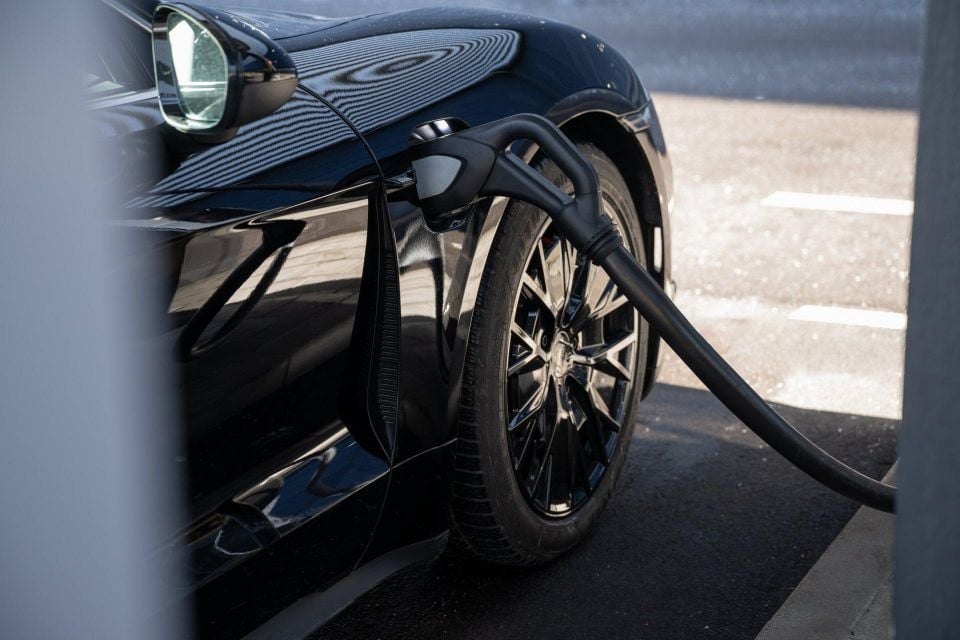
| Running costs | Porsche Taycan |
|---|---|
| Warranty | 3 years, unlimited kilometres (vehicle) 8 years, 160,000 kilometres (battery) |
| Roadside assistance | 3 years (complimentary) 1 year thereon (service activated) |
| Service intervals | 12 months or 15,000 kilometres |
| Capped price servicing | N/A |
| Total capped price service cost | N/A |
If long-term running costs are a concern for you, the Audi e-tron GT offers much of the same running gear with a five-year warranty, six years of free charging with the Chargefox public network, and six years of free servicing.
What a brilliant marvel of engineering.
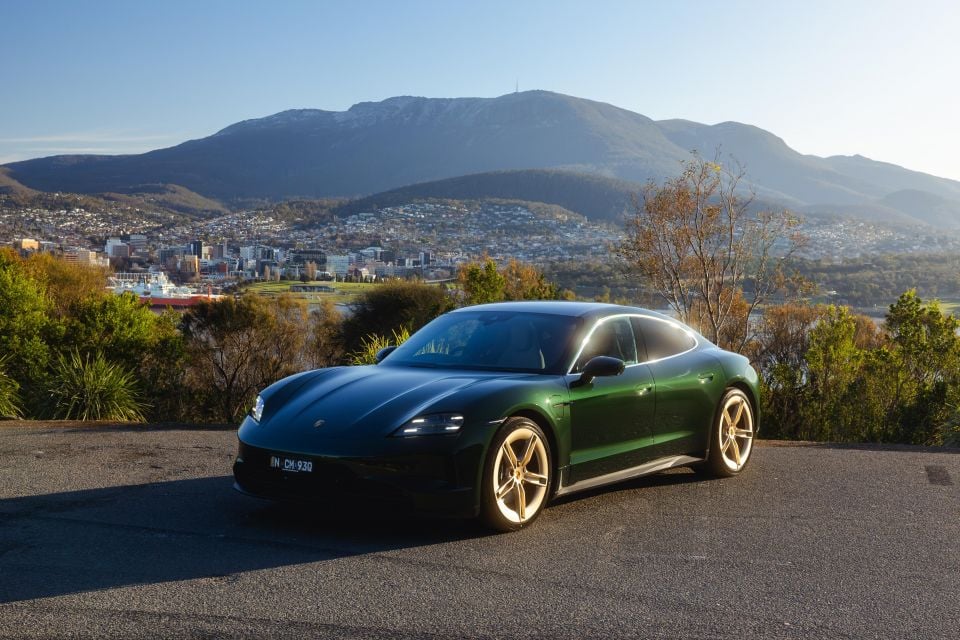
I’ve historically never lusted for Porsches, but something about the Taycan really speaks to me. In the electric space where driver engagement has long taken a back seat, the Taycan still makes you feel something…
The Audi e-tron GT is already a very good car, brilliant even. But the new Porsche takes that to another level. As I said earlier, this isn’t just a very good electric performance car, it’s a performance car that just so happens to be electric.
A vehicle this large and heavy with no singing combustion engine shouldn’t be allowed to be this fun or this fast, and yet it is. The Taycan sets your pulses racing in a straight line, and then makes you smile ear-to-ear in corners.
Further, all of its derivatives are nothing short of excellent. From the single-motor, rear-drive Taycan to the blistering dual-motor Turbo models, it’s fun and feelsome to drive while also comfortable and refined for the everyday stuff.

Many continue to question what the legacy manufacturers have to offer in the electric age in the face of increasing competition from the likes of Tesla and Chinese upstarts, and I think this is a perfect example.
Any company can make a fast EV, any company can shove as many touchscreens and assistance systems into them, but only a select few can make their EVs as fun to drive as combustion-powered equivalents, particularly in the performance space. The Taycan is one of those select few.
Sure it’s not perfect. Plenty of features remain relegated to the options list and ticking boxes can quickly lead to a vehicle that’s $50,000-$100,000 over its base price. Porsche also hasn’t bothered with simulating gearshifts or adding paddle shifters to adjust regen, for example. Nor do I particularly like the dash-mounted drive selector.
But with that said, as much as the Taycan feels like a true Porsche, it’s a true Porsche for the electric age. Without trying to fully replicate the feel of its petrol-fired sports cars in a contrived way, the Taycan stands firm on its values with regards to performance, feel and handling talents to deliver a package that really stands alone.
As Alborz said after the international drive, you don’t need to spend up to the Turbo to get a wholesale change like you might get in a 911. The Taycan and Taycan 4S are plenty fun and fast already, and perhaps better suited to Australia’s public roads.
Porsche, just bring the Sport Turismo to Oz, pretty please…

Click the images for the full gallery
MORE: Buy a Porsche Taycan MORE: Everything Porsche Taycan
Where expert car reviews meet expert car buying – CarExpert gives you trusted advice, personalised service and real savings on your next new car.
James Wong is an automotive journalist and former PR consultant, recognised among Australia’s most prolific motoring writers.


Damion Smy
3 Days Ago


Max Davies
4 Days Ago
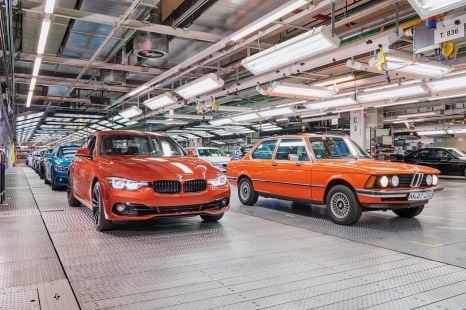

Ben Zachariah
6 Days Ago
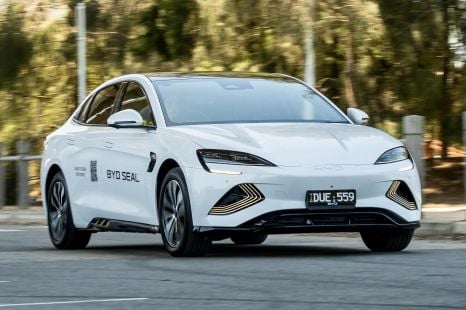

Max Davies
7 Days Ago
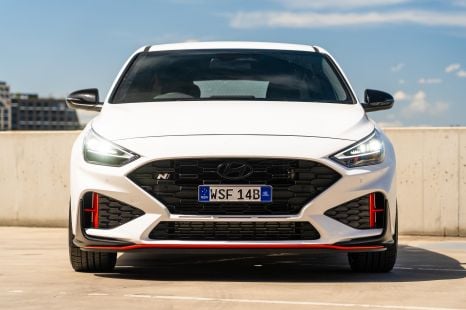

William Stopford
13 Days Ago
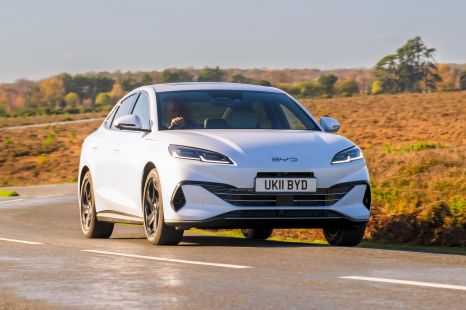

Matt Robinson
16 Days Ago